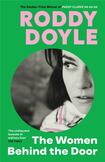
A fascinating thing happens in this, Roddy Doyle’s third novel about domestic violence survivor and (still recovering) alcoholic Paula Spencer. After much mugging about Deliveroo riders, seagulls and “the Covid”, the author essentially turns to the reader, says “We hid behind the jokes. We’re fuckin’ gas – the Irish”, and then proceeds to drop a series of bombshells about the cyclical nature of abuse within his protagonist’s family and in Irish society more broadly.
It’s a key moment, one that reframes the novel’s initial vaudeville energy as a succession of darkly comic coping strategies as well as a kind of national pathology that Doyle proceeds to dismantle with unnerving exactitude in everything that follows.
Essential to this is the compelling protagonist herself. Many will recall the first appearance of the Paula Spencer character in the landmark TV drama Family (1994). Doyle famously touched a raw nerve with that series. He was denounced from church pulpits for besmirching good Catholic homes with his raw depiction of the abuse occurring behind closed doors every day around the country. He received death threats for his portraits of Paula and her brutal husband, Charlo. But he also did a crucial service for the state by making a national conversation about domestic violence unavoidable.
Nonetheless, Doyle had more to say about Paula, as well as about the intersectional collision of trauma, gender and class. He developed the character into his unflinching 1996 novel The Woman Who Walked into Doors and, later, successfully revisited her in the unsentimental Celtic Tiger-era Paula Spencer (2006).
Now, in The Woman Behind the Door, he once again returns to Paula and her family. A lot has changed for her since readers last encountered Paula. She has eased into her grandmaternal years even as she continues her decades-long recovery from abuse. Though the dead Charlo’s voice still taunts her in her head, she can dismiss him much more readily now. She has given up her physically demanding domestic cleaning job (and, with it, the piercing vivisections of Dublin society that it previously permitted the author) and now works as a colour-blind dry cleaner (as ever, Doyle’s light-touch absurdism remains on point).
Many of “her important people are dead”, but “she misses no one. Except herself, maybe. Whatever that means.” This Paula has a bestie to text with; a low-drama, Viagra-popping “man friend”; and, as the novel begins, in 2021, she has her first AstraZeneca appointment.
By opening with the story of Paula “getting her jab”, Doyle pegs the novel to a specific moment of social anxiety. The time he spends on this – on Paula making and attending her Covid-19 vaccination, on her cheekily comparing the attractiveness of inoculators with her friends, and so on – is genuinely refreshing, arguably even commendable, when so much contemporary popular culture seems determined to downplay or entirely omit the pandemic and its impacts.
It is thus of a piece with Doyle’s typical willingness to document things people would rather not discuss, and he treats Covid, fittingly, as a persistent miasma throughout the novel, the disruptions of which present another challenge for his characters to negotiate. Consequently, discussions of social distancing and underlying conditions pepper the text. Arguments break out between minor characters about precautions taken or not. Some even use fake diagnoses as an excuse to absent themselves from their familial obligations.
In fact, Covid is a quiet but persistent presence throughout the whole of The Women Behind the Door (and, in the process, the novel’s title is galvanised by further connotations of both spatial and emotional isolation). When the illness inevitably strikes Paula’s own family, it is with the loaded imagery of violence, “an ache like a huge hand coming down hard on her head”.
While that is a deceptively simple line, it deftly illustrates the way abuse forever colours an individual’s worldview. Indeed, that kind of enmeshed meaning predominates in a novel that pulls in the direction of both the Covid pandemic and the harrowing, multifaceted impact of domestic violence. The most obvious example of this is perhaps the face coverings worn by Paula and others, which Doyle uses to reflect the metaphorical masks we all wear (and always have worn) around others in order to survive.
Doyle’s approach is neither cosy nor asinine. He again takes his time with it
The author brings this to the foreground when Paula’s daughter Nicola, now experiencing domestic troubles of her own, moves back in with her. Nicola is at first reticent to discuss the details, and Doyle, in turn, withholds them from the reader as both women mask the repressed shame and frustration they feel from themselves and from each other. In a way, this is not a surprise as the Paula Spencer books have always been about repression.
The Women Behind the Door is no different, though here Doyle trades the overt subjugation of a husband’s fists for an even more insidious kind of control, that of predatory sexual comments and insinuations loudly declaimed and then brushed off as just having a laugh. That such remarks are here delivered in the presence of “superspreaders” is the author’s most unsettling and meaningful linkage of pandemic imagery to the core themes of the Paula Spencer saga: misogyny is as viral as anything else in our culture.
Unpacking this is delicate and upsetting work. As with Family and The Woman Who Walked into Doors, this is not writing that makes us comfortable. This is work that makes us angry, even ashamed of our society for how readily it has “hid behind the jokes”. Doyle’s approach is neither cosy nor asinine. He again takes his time with it. He carefully dramatises the chilling effect such unchallenged behaviour has on women and on teenage girls even as the novel broaches more serious violations of familial trust. In the process he eviscerates the notion of the male gaze by removing it from valuable but inevitably sterile academic discourse and making real the high personal cost (and often generational trauma) of its domineering and lascivious intent. Of Paula’s reaction to some of the things she learns, he writes, “She was going to be sick. Again. She wanted to vomit. To pour it – hurl it out. Get rid of it. The evil.”
Suffice to say, the passages in which Paula and Nicola circle these topics are among the most accomplished in the novel. Their conversations are realistically circuitous. They are powerful back-and-forths in which both needle each other relentlessly before expressing the kind of vulnerability unique to the parent-child relationship, and, subsequently, devolving into name-calling once more. This mother and daughter have frequently been at odds, yes, but these are charged exchanges in which neither wants to give the solidity of words to what they need to express.
Such stretches are difficult to read but easy to follow. They confirm how catharsis, as those familiar with Paula’s journey know, can be at once a glorious and a delicate thing. Which is to say that Doyle is not in the business of offering solutions here, easy or otherwise. Those are, in the end, for the reader to reflect upon.
Thus the novel constitutes a classic Doyle challenge to the reader’s self-satisfaction. It fits stylistically with its predecessors – Paula continues to flit between the present and her memories – as well as dovetailing with (and in fact expanding upon) Doyle’s stated intention of giving voice to a character type consciously sidelined by Irish society. It also furthers the author’s established interest in the multiculturalism of modern Ireland and, though sociopolitical commentary is less prominent here than elsewhere, Doyle is forever cognisant of how global crises reverberate through the lives of everyday people. This is true not just of the pandemic, but of the events such as the war in Ukraine and the malignant influence of macho caricatures such as Trump, Orbán, and Putin, who all receive shout-outs.
It’s only a shame that, publishing schedules being what they are, we have been denied a Doyle/Paula zinger about JD Vance’s retrograde notions concerning women. That would have slotted in quite well.
Yet if The Women Behind the Door is to be the end of Paula Spencer’s story then it feels less like an epilogue and more like a capstone, one embedded with a time capsule recording our extraordinarily odd recent years. So too is it a shot across the bow of our complacency. For it may be 30 years since we first met Paula Spencer, and both the character and the country may have been transformed in a multitude of unexpected ways since then, but Roddy Doyle knows full well that many of the issues that Paula forced us to confront remain or have, in viral fashion, mutated into stealthy but toxic new strains.
Further Reading
The Barrytown Trilogy by Roddy Doyle (Vintage, 2013). Back where it all began. Doyle’s beloved early novels (The Commitments 1987; The Snapper, 1990; and The Van, 1991) defined a gritty but comedic vision of Dublin for a generation and heralded the arrival of an arresting new voice. Famously compared the experience of northsiders to that of African-Americans.
The Country Girls Trilogy by Edna O’Brien (Faber, 2019). Collected edition of the taboo-breaking 1960s classics initially banned in Ireland. The work of a formidable and fearless author keen to tackle depictions of female desire in a morally restrictive patriarchal society. Feminist bildungsroman writing for the ages.
The Ballymun Trilogy by Dermot Bolger (New Island, 2010). Three plays set in the northside suburb commissioned as part of its social regeneration plan. Offers interwoven stories of promise, trauma and resurgence. An encapsulation of Ballymun as far more than just lazy stereotypes of degradation.













